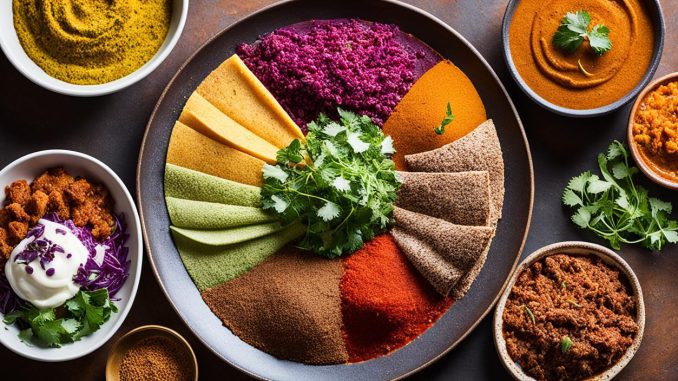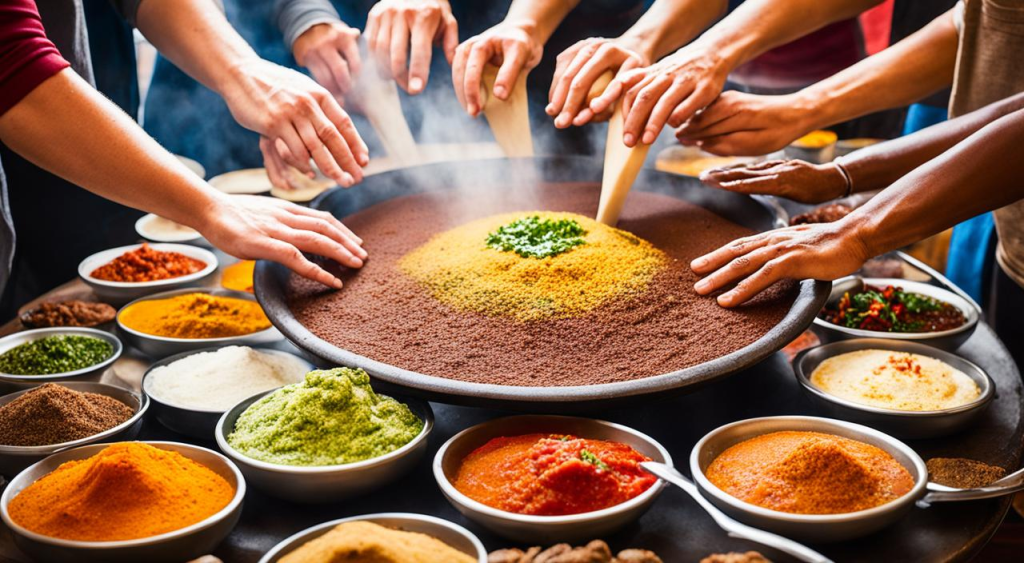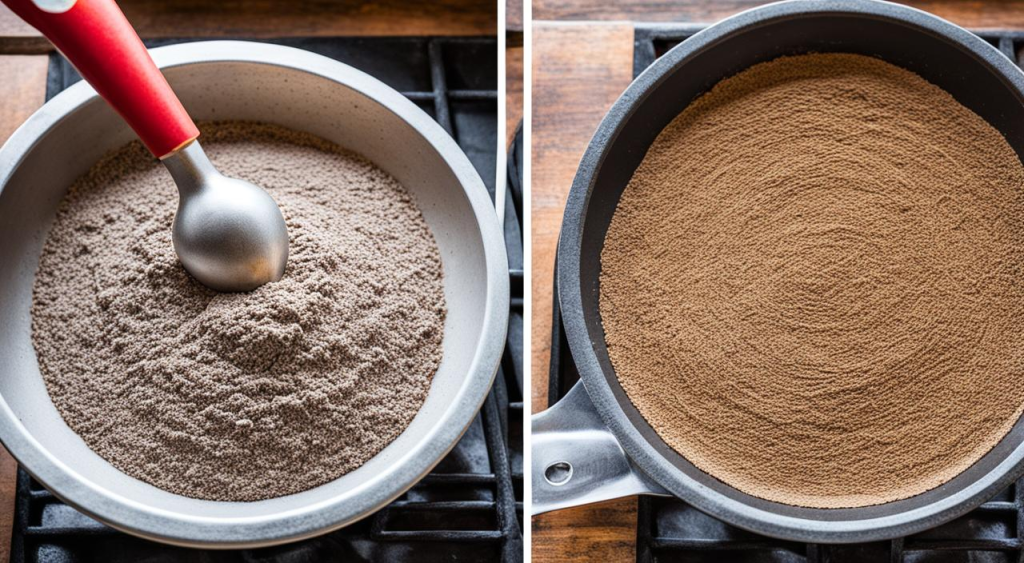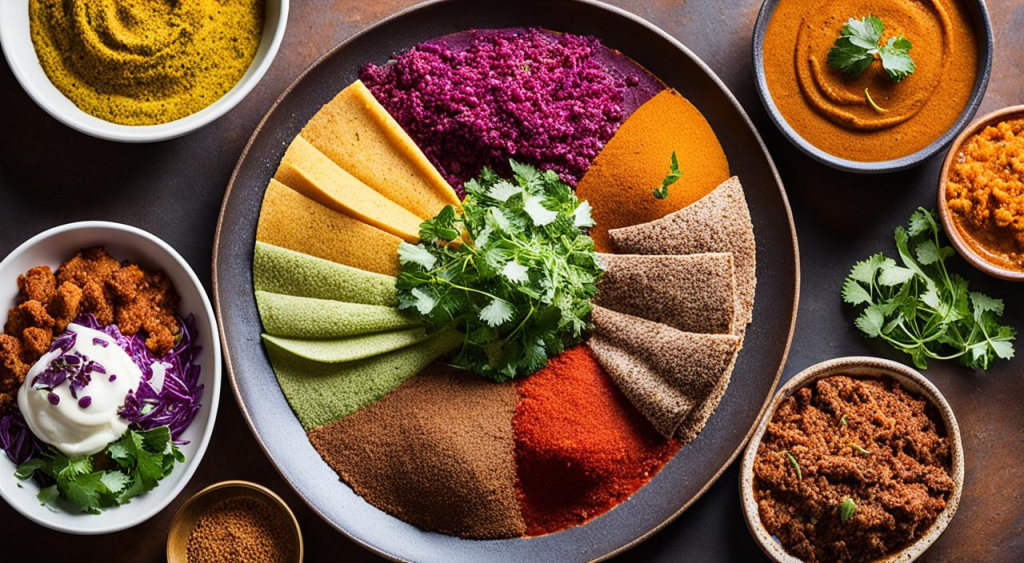
Injera: The Heart and Soul of Ethiopian Meals
In Ethiopia, injera is more than just food. It’s the heart of their meals. This spongy, fermented flatbread is a key part of their culture. It’s what makes their food rich and full of flavor.
Injera is the base for many dishes, from stews to vegetables. It brings together different tastes and textures. This makes eating in Ethiopia a special experience.

Key Takeaways
- Injera is the quintessential staple food and foundation of Ethiopian cuisine.
- This spongy, fermented flatbread is not only a dietary mainstay but also holds immense cultural significance in Ethiopian society.
- Serving as the base for a variety of savory stews and vegetable dishes, injera is considered the heart and soul of an Ethiopian meal.
- Injera seamlessly integrates flavors and textures, creating a truly unique dining experience.
- Injera is deeply rooted in the culinary traditions and identity of Ethiopia.
What is Injera?
Injera is a spongy, slightly sour flatbread that is key to many traditional Ethiopian dishes. It’s mainly made from teff, a small, nutritious grain from the Horn of Africa. This bread has a unique pancake-like texture and a tangy taste. It goes well with the rich, spiced stews and vegetable dishes it’s served with.
The Staple Bread of Ethiopian Cuisine
Injera is a must-have in Ethiopian cuisine, playing a big role in the country’s food culture. It’s a key part of the wat (stew) and alecha (vegetable dish) meals. The long fermentation process makes injera special, giving it holes and a spongy look.
Unique Texture and Flavor
The fermentation process not only makes injera’s texture unique but also gives it a tangy taste. This flavor balances the rich, spicy tastes of Ethiopian dishes. Injera’s spongy and slightly sour nature makes it a great tool for picking up stews and sauces.
| Injera Bread Composition | Injera Bread Features |
|---|---|
| Primary ingredient: Teff flourAdditional ingredients: Water, yeast, and sometimes barley or wheat flour | Spongy, pancake-like textureDistinctive tangy flavorResult of long fermentation processServes as a staple food in traditional Ethiopian cuisine |
“Injera is not just a bread, it’s the heart and soul of Ethiopian cuisine.”
Injera: The Heart and Soul of Ethiopian Meals
In Ethiopia, injera is more than just food; it’s a key part of the culture. This spongy flatbread is the base of traditional meals. It’s used as both a utensil and a plate. People use injera to pick up stews, vegetables, and meats, making every bite special.
The cultural significance of injera is huge in Ethiopian food. It’s the main part of a meal, making it feel whole. Without injera, a meal wouldn’t be complete. It shows how injera is key to Ethiopian cuisine.
“Injera is not just a bread, it’s a way of life in Ethiopia. It’s the foundation of our meals, the glue that holds our culinary traditions together.”
Injera is also used as a utensil in Ethiopia. People use it to eat the dishes with it. This makes the meal more enjoyable, mixing the bread’s taste with the food’s flavors.

In conclusion, injera is more than a food in Ethiopia. It’s a key part of the culture and identity. From its role in meals to its cultural importance, injera is the heart and soul of Ethiopian cuisine.
Traditional Injera Preparation
Making injera, the main bread in Ethiopian food, is a special process. It needs skill and patience. The key to its unique taste and texture is the fermentation process.
The Art of Fermentation
It starts with picking and grinding teff flour, the main ingredient. Then, the flour is mixed with water and left to ferment for days. This step is important. It lets the natural yeasts and bacteria work, making the batter tangy and light.
Cooking Techniques and Tools
- After fermenting, the batter is poured on a traditional clay griddle called a mitad.
- A special tool, the mesob, spreads the batter evenly, making the characteristic holes.
- The cook watches closely, flipping the injera to get a golden-brown color on both sides.
This careful process has been passed down for generations. It’s a big part of Ethiopia’s food culture. Making injera is more than just cooking. It’s an art that honors the traditional ways and tools used to make this bread.

Injera’s Versatility
Injera is more than just a staple bread in traditional Ethiopian cuisine. It’s a base, a utensil, and even a plate. It perfectly complements the wide variety of stews, vegetable dishes, and meats found on Ethiopian tables.
Its spongy texture makes it great at soaking up sauces and juices. This creates a delicious and satisfying meal. Ethiopians use injera in many ways, making sure every bite is full of flavor.
As a utensil, injera is flexible and strong. It can be torn and folded easily. This makes it ideal for enjoying injera with different Ethiopian dishes.
| Dish | Injera’s Role |
|---|---|
| Wat (Stew) | Injera serves as a scoop to gather and consume the rich, flavorful stew. |
| Kitfo (Minced Beef) | Injera is used to wrap and eat the spicy, raw beef dish. |
| Shiro (Chickpea Stew) | Injera is used to dip into and soak up the creamy, savory stew. |
Injera’s ability to work well with many flavors makes it the heart of Ethiopian meals.

“Injera is not just a bread, it’s a way of life in Ethiopia. It’s the foundation that holds our culinary traditions together.”
– Chef Mulugeta Abay, renowned Ethiopian culinary expert
Nutritional Value of Injera
Injera is more than just a tasty bread from Ethiopian cuisine. It’s also a great choice for your health. Made from teff, a grain native to the area, it’s full of fiber, protein, and important vitamins and minerals.
A Wholesome and Nourishing Choice
The way injera is made, by fermenting it, makes it even better for you. This process helps make more nutrients available. So, injera is a great choice for those looking for a healthy option in their diet.
It’s full of fiber and protein, offering many nutritional benefits. This makes it a nutritious alternative for anyone wanting to eat better.
Eating injera helps Ethiopians keep their food traditions alive. It also supports their health and well-being. The nutritional advantages of injera make it a great addition to any diet. It’s a tasty and nourishing choice for those looking to enjoy the flavors and health benefits of this Ethiopian staple.
FAQ
What is Injera?
Injera is a key food in Ethiopian cuisine. It’s a spongy, fermented flatbread made from teff flour. This tiny grain is native to the Horn of Africa. Injera has a unique taste and texture that goes well with spicy stews and vegetables.
What is the cultural significance of Injera in Ethiopian meals?
Injera is more than just food in Ethiopia; it’s a big part of their culture. It’s the main part of a meal, used as both a utensil and a plate. People use it to eat various dishes, making every bite flavorful and textured.
How is Injera traditionally prepared?
Making injera is an old tradition that needs skill and patience. It starts with fermenting teff flour for days to get the right taste and texture. Then, the batter is cooked on a clay griddle with a special tool to make the bread’s signature holes.
How versatile is Injera?
Injera is more than just a bread. It’s used as a base, utensil, and plate in Ethiopian meals. It helps to soak up the flavors of various dishes, making meals enjoyable and satisfying.
What are the nutritional benefits of Injera?
Injera is not just a food staple; it’s also nutritious. Made from teff, it’s full of fiber, protein, and vitamins. The fermentation process makes it even more nutritious. So, injera is a healthy choice that supports well-being in Ethiopia.